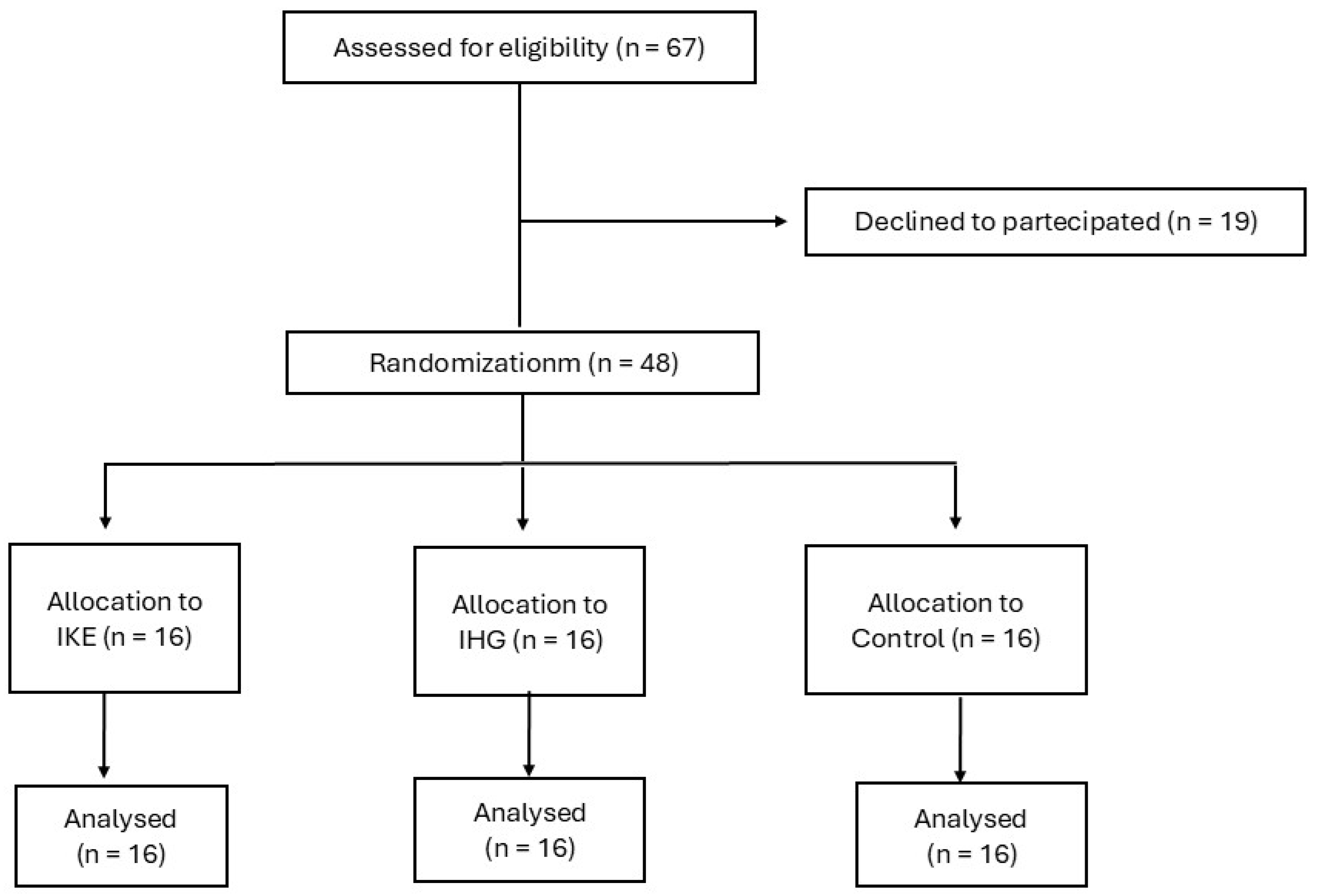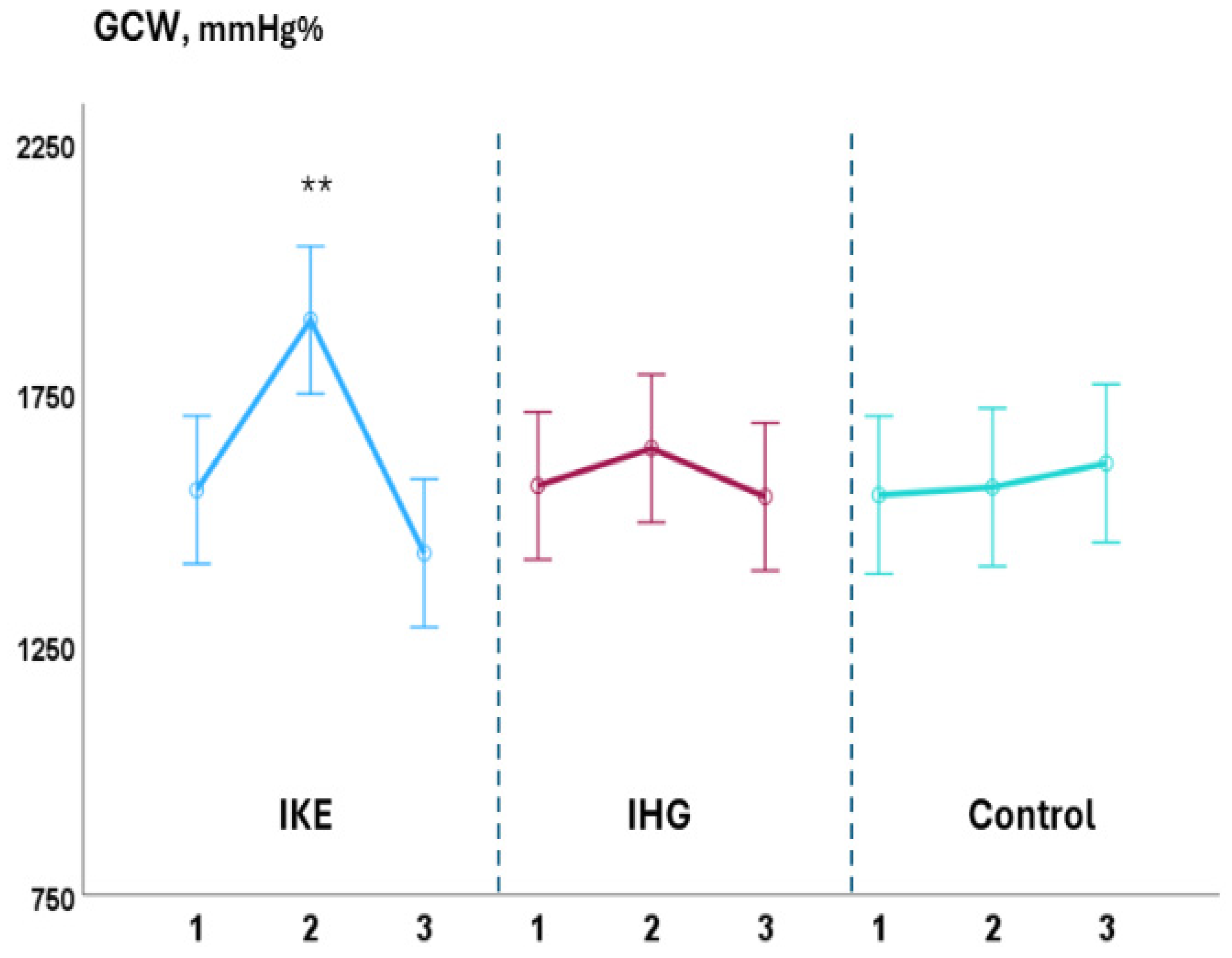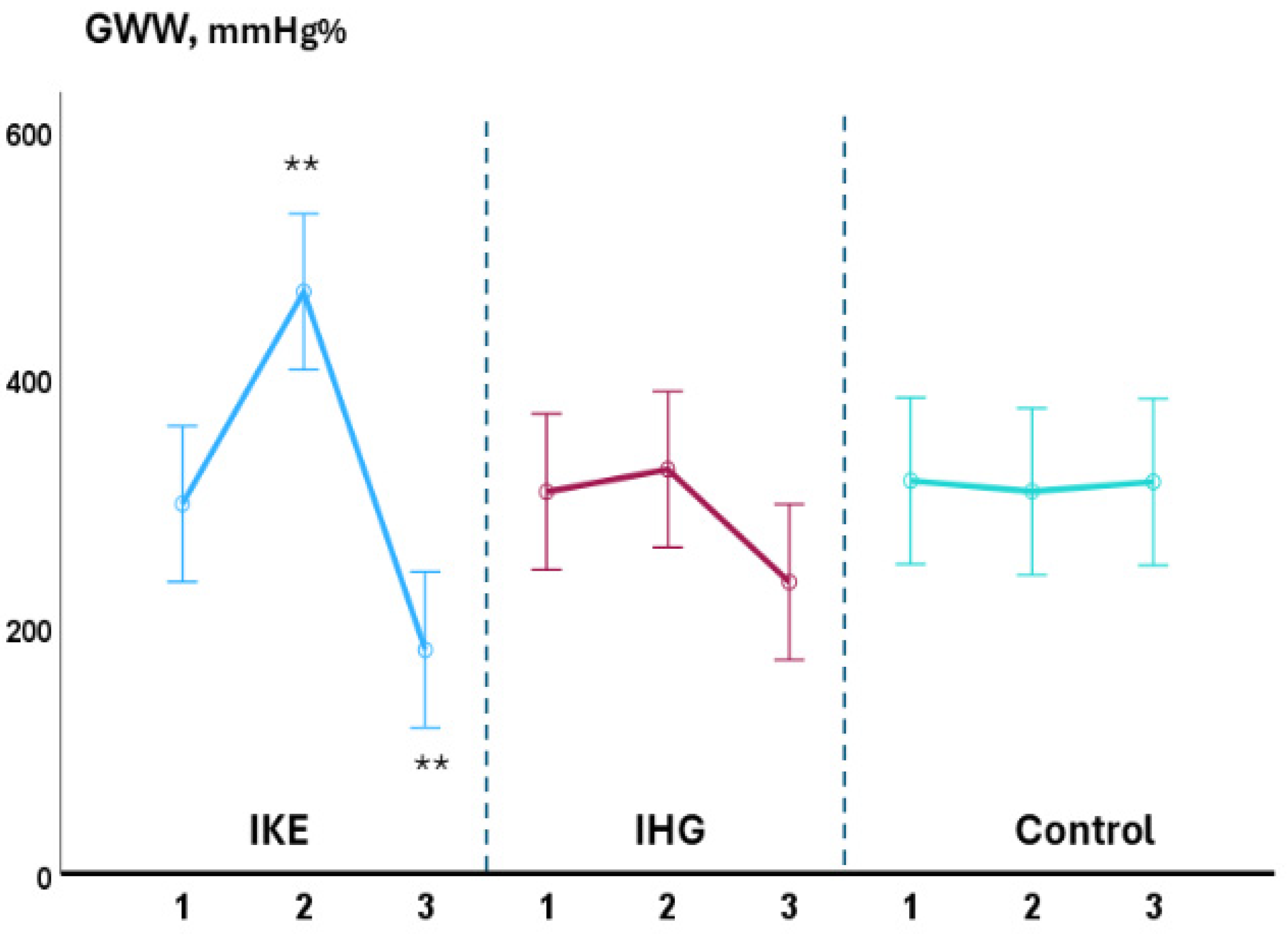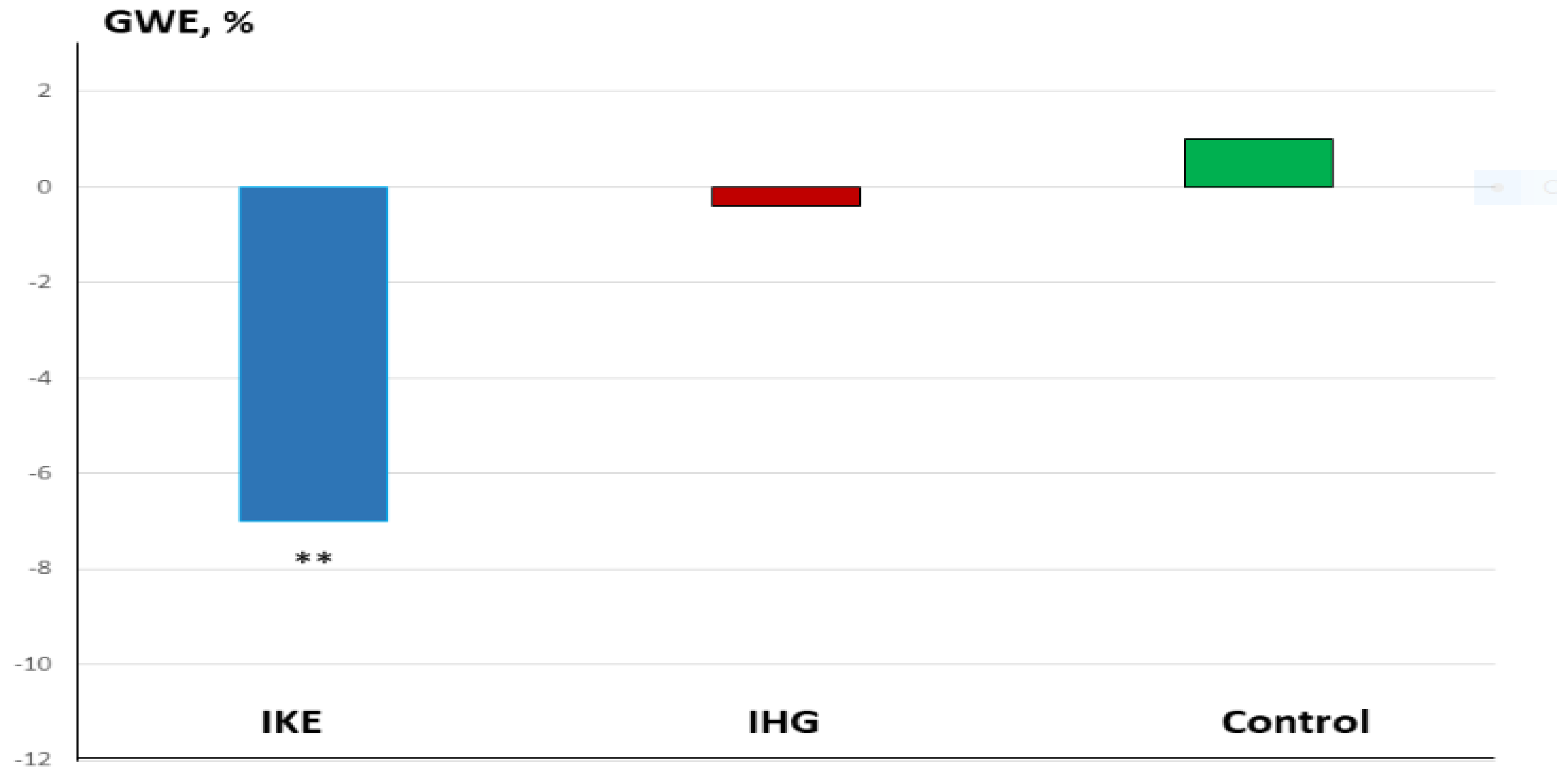Effect of Different Isometric Exercise Modalities on Myocardial Work in Trained Hypertensive Patients with Ischemic Heart Disease: A Randomized Pilot Study
Abstract
1. Introduction
2. Materials and Methods
2.1. Population
2.2. Study Design
2.3. Echocardiography
2.4. Experimental Sessions
2.5. Statistical Analysis
3. Results
3.1. Intra-Group Changes
3.2. Between-Groups Changes
4. Discussion
5. Conclusions
Author Contributions
Funding
Institutional Review Board Statement
Informed Consent Statement
Data Availability Statement
Conflicts of Interest
References
- Pescatello, L.S.; Buchner, D.M.; Jakicic, J.M.; Powell, K.E.; Kraus, W.E.; Bloodgood, B.; Campbell, W.W.; Dietz, S.; Dipietro, L.; George, S.M.; et al. Physical Activity to Prevent and Treat Hypertension: A Systematic Review. Med. Sci. Sports Exerc. 2019, 51, 1314–1323. [Google Scholar] [PubMed]
- McEvoy, J.W.; McCarthy, C.P.; Bruno, R.M.; Brouwers, S.; Canavan, M.D.; Ceconi, C.; Christodorescu, R.M.; Daskalopoulou, S.S.; Ferro, C.J.; Gerdts, E.; et al. ESC Scientific Document Group. 2024 ESC Guidelines for the management of elevated blood pressure and hypertension. Eur. Heart J. 2024, 45, 3912–4018. [Google Scholar] [PubMed]
- Baffour-Awuah, B.; Pearson, M.J.; Dieberg, G.; Smart, N.A. Isometric Resistance Training to Manage Hypertension: Systematic Review and Meta-analysis. Curr. Hypertens. Rep. 2023, 25, 35–49. [Google Scholar] [PubMed]
- Edwards, J.; De Caux, A.; Donaldson, J.; Wiles, J.; O’Driscoll, J. Isometric exercise versus high-intensity interval training for the management of blood pressure: A systematic review and meta-analysis. Br. J. Sports Med. 2022, 56, 506–514. [Google Scholar]
- Jae, S.Y.; Yoon, E.S.; Kim, H.J.; Cho, M.J.; Choo, J.; Kim, J.Y.; Kunutsor, S.K. Isometric handgrip versus aerobic exercise: A randomized trial evaluating central and ambulatory blood pressure outcomes in older hypertensive participants. J. Hypertens. 2025, 43, 351–358. [Google Scholar]
- Miura, S. Evidence for exercise therapies including isometric handgrip training for hypertensive patients. Hypertens. Res. 2024, 48, 846–848. [Google Scholar]
- Alves, A.J.; Viana, J.L.; Cavalcante, S.L.; Oliveira, N.L.; Duarte, J.A.; Mota, J.; Oliveira, J.; Ribeiro, F. Physical activity in primary and secondary prevention of cardiovascular disease: Overview updated. World J. Cardiol. 2016, 8, 575–583. [Google Scholar]
- Suga, H.; Hayashi, T.; Shirahata, M. Ventricular systolic pressure-volume area as predictor of cardiac oxygen consumption. Am. J. Physiol. 1981, 240, H39–H44. [Google Scholar]
- Hanson, P.; Nagle, F. Isometric exercise: Cardiovascular responses in normal and cardiac populations. Cardiol. Clin. 1987, 5, 157–170. [Google Scholar]
- Kleijn, S.A.; Aly, M.F.; Terwee, C.B.; van Rossum, A.C.; Kamp, O. Three-dimensional speckle tracking echocardiography for automatic assessment of global and regional left ventricular function based on area strain. J. Am. Soc. Echocardiogr. 2011, 24, 314–321. [Google Scholar]
- Luis, S.A.; Yamada, A.; Khandheria, B.K.; Speranza, V.; Benjamin, A.; Ischenko, M.; Platts, D.G.; Hamilton-Craig, C.R.; Haseler, L.; Burstow, D.; et al. Use of three-dimensional speckle-tracking echocardiography for quantitative assessment of global left ventricular function: A comparative study to three-dimensional echocardiography. J. Am. Soc. Echocardiogr. 2014, 27, 285–291. [Google Scholar] [CrossRef] [PubMed]
- Lotti, R.; de Marzo, V.; Della Bona, R.; Porto, I.; Rosa, G.M. Speckle-tracking echocardiography: State of art and its applications. Minerva Med. 2023, 114, 500–551. [Google Scholar] [CrossRef] [PubMed]
- Martini, L.; Lisi, M.; Pastore, M.C.; Righini, F.M.; Rubboli, A.; Henein, M.Y.; Cameli, M. The Role of Speckle Tracking Echocardiography in the Evaluation of Advanced-Heart-Failure Patients. J. Clin. Med. 2024, 13, 4037. [Google Scholar] [CrossRef] [PubMed]
- Pescariu, S.-A.; Şoşdean, R.; Tudoran, C.; Ionac, A.; Pop, G.N.; Timar, R.Z.; Pescariu, S.; Tudoran, M. Echocardiographic Parameters as Predictors for the Efficiency of Resynchronization Therapy in Patients with Dilated Cardiomyopathy and HFrEF. Diagnostics 2022, 12, 35. [Google Scholar] [CrossRef]
- Cacciapuoti, F.; Paoli, V.D.; Scognamiglio, A.; Caturano, M.; Cacciapuoti, F. Left Atrial Longitudinal Speckle Tracking Echocardiography in Healthy Aging Heart. J. Cardiovasc. Echogr. 2015, 25, 40–45. [Google Scholar] [CrossRef]
- Mandraffino, G.; Imbalzano, E.; Lo Gullo, A.; Zito, C.; Morace, C.; Cinquegrani, M.; Savarino, F.; Oreto, L.; Giuffrida, C.; Carerj, S.; et al. Abnormal left ventricular global strain during exercise-test in young healthy smokers. Sci. Rep. 2020, 10, 5700. [Google Scholar] [CrossRef]
- Forsythe, L.; George, K.; Oxborough, D. Speckle Tracking Echocardiography for the Assessment of the Athlete’s Heart: Is. It Ready for Daily Practice? Curr. Treat. Options Cardiovasc. Med. 2018, 20, 83. [Google Scholar] [CrossRef]
- Sugimoto, T.; Bandera, F.; Generati, G.; Alfonzetti, E.; Bussadori, C.; Guazzi, M. Left Atrial Function Dynamics During Exercise in Heart Failure: Pathophysiological Implications on the Right Heart and Exercise Ventilation Inefficiency. JACC Cardiovasc. Imaging. 2017, 10 Pt B, 1253–1264. [Google Scholar] [CrossRef]
- Perrone, M.A.; Iellamo, F.; D’Antoni, V.; Gismondi, A.; Di Biasio, D.; Vadalà, S.; Marazzi, G.; Morsella, V.; Volterrani, M.; Caminiti, G. Acute Changes on Left Atrial Function during Incremental Exercise in Patients with Heart Failure with Mildly Reduced Ejection Fraction: A Case-Control Study. J. Pers. Med. 2023, 13, 1272. [Google Scholar] [CrossRef]
- Trimarchi, G.; Carerj, S.; Di Bella, G.; Manganaro, R.; Pizzino, F.; Restelli, D.; Pelaggi, G.; Lofrumento, F.; Licordari, R.; Taverna, G.; et al. Clinical Applications of Myocardial Work in Echocardiography: A Comprehensive Review. J. Cardiovasc. Echogr. 2024, 34, 99–113. [Google Scholar] [CrossRef]
- Virani, S.S.; Newby, L.K.; Arnold, S.V.; Bittner, V.; Brewer, L.C.; Demeter, S.H.; Dixon, D.L.; Fearon, W.F.; Hess, B.; Johnson, H.M.; et al. Peer Review Committee Members. 2023 AHA/ACC/ACCP/ASPC/NLA/PCNA Guideline for the Management of Patients With Chronic Coronary Disease: A Report of the American Heart Association/American College of Cardiology Joint Committee on Clinical Practice Guidelines. Circulation 2023, 148, e9–e119. [Google Scholar] [PubMed]
- Eldridge, S.M.; Chan, C.L.; Campbell, M.J.; Bond, C.M.; Hopewell, S.; Thabane, L.; Lancaster, G.A. PAFS consensus group. CONSORT 2010 statement: Extension to randomised pilot and feasibility trials. BMJ 2016, 355, i5239. [Google Scholar] [CrossRef] [PubMed]
- Nagueh, S.F.; Smiseth, O.A.; Appleton, C.P.; Byrd, B.F., 3rd; Dokainish, H.; Edvardsen, T.; Flachskampf, F.A.; Gillebert, T.C.; Klein, A.L.; Lancellotti, P.; et al. Recommendations for the Evaluation of Left Ventricular Diastolic Function by Echocardiography: An Update from the American Society of Echocardiography and the European Association of Cardiovascular Imaging. Eur. Heart J. Cardiovasc. Imaging. 2016, 17, 1321–1360. [Google Scholar] [PubMed]
- Papadopoulos, K.; Özden Tok, Ö.; Mitrousi, K.; Ikonomidis, I. Myocardial Work: Methodology and Clinical Applications. Diagnostics 2021, 11, 573. [Google Scholar] [CrossRef]
- Flight, L.; Julious, S.A. Practical guide to sample size calculations: An introduction. Pharm. Stat. 2016, 15, 68–74. [Google Scholar] [CrossRef]
- Caminiti, G.; Volterrani, M.; Iellamo, F.; Marazzi, G.; D’Antoni, V.; Calandri, C.; Vadalà, S.; Catena, M.; Di Biasio, D.; Manzi, V.; et al. Acute Changes in Myocardial Work during Isometric Exercise in Hypertensive Patients with Ischemic Heart Disease: A Case-Control Study. J. Clin. Med. 2024, 13, 5955. [Google Scholar] [CrossRef]
- Beaumont, A.; Sculthorpe, N.; Hough, J.; Unnithan, V.; Richards, J. Global and regional left ventricular circumferential strain during incremental cycling and isometric knee extension exercise. Echocardiography 2018, 35, 1149–1156. [Google Scholar]
- O’Driscoll, J.M.; Edwards, J.J.; Wiles, J.D.; Taylor, K.A.; Leeson, P.; Sharma, R. Myocardial work and left ventricular mechanical adaptations following isometric exercise training in hypertensive patients. Eur. J. Appl. Physiol. 2022, 122, 727–734. [Google Scholar] [CrossRef]
- Rovithis, D.; Anifanti, M.; Koutlianos, N.; Teloudi, A.; Kouidi, E.; Deligiannis, A. Left Ventricular Diastolic Response to Isometric Handgrip Exercise in Physically Active and Sedentary Individuals. J. Cardiovasc. Dev. Dis. 2022, 9, 389. [Google Scholar] [CrossRef]
- Mitter, S.S.; Shah, S.J.; Thomas, J.D. A Test in Context: E/A and E/e’ to Assess Diastolic Dysfunction and LV Filling Pressure. J. Am. Coll. Cardiol. 2017, 69, 1451–1464. [Google Scholar] [CrossRef]
- Carluccio, E.; Cameli, M.; Rossi, A.; Dini, F.L.; Biagioli, P.; Mengoni, A.; Jacoangeli, F.; Mandoli, G.E.; Pastore, M.C.; Maffeis, C.; et al. Left Atrial Strain in the Assessment of Diastolic Function in Heart Failure: A Machine Learning Approach. Circ. Cardiovasc. Imaging. 2023, 16, e014605. [Google Scholar] [PubMed]
- Olher, R.D.R.V.; Bocalini, D.S.; Bacurau, R.F.; Rodriguez, D.; Figueira, A., Jr.; Pontes, F.L., Jr.; Navarro, F.; Simões, H.G.; Araujo, R.C.; Moraes, M.R. Isometric handgrip does not elicit cardiovascular overload or post-exercise hypotension in hypertensive older women. Clin. Interv. Aging. 2013, 8, 649–655. [Google Scholar] [PubMed]
- Coneglian, J.C.; Barcelos, G.T.; Bandeira, A.C.N.; Carvalho, A.C.A.; Correia, M.A.; Farah, B.Q.; Ritti-Dias, R.M.; Gerage, A.M. Acute Blood Pressure Response to Different Types of Isometric Exercise: A Systematic Review with Meta-Analysis. Rev. Cardiovasc. Med. 2023, 24, 60. [Google Scholar] [PubMed]
- Lin, S.; Sun, P.; Huang, L.; Hernandez, M.; Yu, H.; Jan, Y.K. Effects of the intensity, duration and muscle mass factors of isometric exercise on acute local muscle hemodynamic responses and systematic blood pressure regulation. Front. Bioeng. Biotechnol. 2024, 12, 1444598. [Google Scholar]
- Kounoupis, A.; Papadopoulos, S.; Galanis, N.; Dipla, K.; Zafeiridis, A. Are Blood Pressure and Cardiovascular Stress. Greater in Isometric or in Dynamic Resistance Exercise? Sports 2020, 8, 41. [Google Scholar] [CrossRef]
- Swift, H.T.; O’Driscoll, J.M.; Coleman, D.D.; Caux, A.; Wiles, J.D. Acute cardiac autonomic and haemodynamic responses to leg and arm isometric exercise. Eur. J. Appl. Physiol. 2022, 122, 975–985. [Google Scholar]
- Oliveira, P.C.; Silva, M.R.; Lehnen, A.M.; Waclawovsky, G. Isometric handgrip training, but not a single session, reduces blood pressure in individuals with hypertension: A systematic review and meta-analysis. J. Hum. Hypertens. 2023, 37, 844–853. [Google Scholar]
- van Assche, T.; Buys, R.; de Jaeger, M.; Coeckelberghs, E.; Cornelissen, V.A. One single bout of low-intensity isometric handgrip exercise reduces blood pressure in healthy pre- and hypertensive individuals. J. Sports Med. Phys. Fitness 2017, 57, 469–475. [Google Scholar]
- Goessler, K.; Buys, R.; Cornelissen, V.A. Low-intensity isometric handgrip exercise has no transient effect on blood pressure in patients with coronary artery disease. J. Am. Soc. Hypertens. 2016, 10, 633–639. [Google Scholar]
- Souza, L.R.; Vicente, J.B.; Melo, G.R.; Moraes, V.C.; Olher, R.R.; Sousa, I.C.; Peruchi, L.H.; Neves, R.V.; Rosa, T.S.; Ferreira, A.P.; et al. Acute Hypotension After Moderate-Intensity Handgrip Exercise in Hypertensive Elderly People. J. Strength. Cond. Res. 2018, 32, 2971–2977. [Google Scholar]
- Ilardi, F.; D’Andrea, A.; D’Ascenzi, F.; Bandera, F.; Benfari, G.; Esposito, R.; Malagoli, A.; Mandoli, G.E.; Santoro, C.; Russo, V.; et al. Myocardial Work by Echocardiography: Principles and Applications in Clinical Practice. J. Clin. Med. 2021, 10, 4521. [Google Scholar] [CrossRef]





| IKE (n = 16) | IHG (n = 16) | Control (n = 16) | |
| Age, years | 64.9 ± 14.7 | 63.4 ± 16.1 | 64.2 ± 13.5 |
| Male/female, n | 14/2 | 14/1 | 7/1 |
| BMI, kg/m2 | 27.1 ± 5.5 | 28.2 ± 8.0 | 27.5 ± 7.3 |
| BSA, m2 | 1.88 ± 1.1 | 1.93 ± 0.8 | 1.91 ± 1.3 |
| Previous STEMI | 13 (81) | 11 (69) | 12 (75) |
| PCI, n (%) | 11 (69) | 10 (62) | 10 (62) |
| CABG, n (%) | 8 (50) | 7 (44) | 9 (56) |
| Physical activity (min/week) | 174 | 178 | 173 |
| HR, bpm | 66.8 ± 13.6 | 63.5 ± 11.4 | 65.2 ± 8.2 |
| SBP, mmHg | 128.9 ± 27.5 | 135.2 ± 33.8 | 136.7 ± 32.1 |
| DBP, mmHg | 81.6 ± 9.2 | 80.9 ± 12.4 | 81.8 ± 1.3 |
| Comorbidities | |||
| Diabetes, n (%) | 3 (19) | 2 (12) | 3 (19) |
| Hypercholesterolemia, n (%) | 14 (87) | 15 (94) | 14 (87) |
| GFR < 60 mL/min/1.73 m2 | 3 (19) | 4 (25) | 2 (25) |
| Previous smoke habit, n (%) | 8 (50) | 10 (62) | 8 (50) |
| Echocardiography | |||
| LVEDV, mL | 140.4 ± 33,4 | 136.3 ± 32.4 | 137 ± 32.4 |
| LVESV, mL | 70.5 ± 11.7 | 67.0 ± 26.3 | 69.4 ± 19.4 |
| LVEF, % | 50.3 ± 7.4 | 49.2 ± 8.2 | 50.3 ± 11.4 |
| LVGLS, % | −12.4 ± 3.8 | −13.1 ± 3.5 | −12.9 ± 3.1 |
| GWI, % | 1150.5 ± 412.6 | ì284.9 ± 492.0 | 1198 ± 331.6 |
| GCW, % | 1601.3 ± 491.8 | 1678 ± 558.3 | 1523 ± 341.9 |
| GWW, % | 338.7 ± 127.7 | 345.2 ± 198.9 | 344.3 ± 166.5 |
| GWE, % | 82.5 ± 11.7 | 82.8 ± 9.7 | 81.5 ± 13.1 |
| DT, ms | 208.7 ± 60.4 | 197.4 ± 37.5 | 211.7 ± 44.5 |
| E, cm/s | 48.1 ± 9.0 | 50.6 ± 13.0 | 52.3 ± 12.3 |
| A, cm/s | 66.4 ± 16.1 | 67.3 ± 13.9 | 66.9 ± 14.1 |
| E/A ratio | 0.75 ± 0.16 | 0.75 ± 0.22 | 0.78 ± 0.13 |
| e’, cm/s | 5.9 ± 1.5 | 6.2 ± 2.2 | 6.3 ± 2.2 |
| E/e’ ratio | 8.1 ± 1.9 | 8.1 ± 2.6 | 8.3 ± 2.3 |
| TRV, m/s | 1.9 ± 0.4 | 2.1 ± 0.1 | 1.7 ± 0.4 |
| PALS, % | 19.7 ± 8.5 | 21.4 ± 6.0 | 19.2 ± 6.0 |
| PACS, % | −13.9 ± 3.5 | −15.4 ± 3.5 | −15 7 ± 4.3 |
| LAVI, mL/m2 | 31.6 ± 7.2 | 34.2 ± 10.3 | 32.72 ± 9.1 |
| SV, mL | 70.3 ± 14.3 | 72.0 ± 14.4 | 69.3 ± 16.4 |
| CO, L/min | 4.7 ± 1.1 | 4.6 ± 1.0 | 4.5 ± 1.6 |
| Treatment | |||
| Anti-platelets agents, n (%) | 16 (100) | 16 (100) | 16 (100) |
| ACE-Is/ARBs, n (%) | 15 (94) | 16 (100) | 15 (94) |
| Beta-blockers, n (%) | 16 (100) | 16 (100) | 8 (100) |
| Tiazidics, n (%) | 4 (25) | 5 (31) | 5 (31) |
| CCAs, n (%) | 5 (31) | 6 (37) | 7 (44) |
| Ranolazine, n (%) | 3 (19) | 2 (12) | 2 (12) |
| Furosemide, n (%) | 1 (6) | 2 (12) | - |
| Statins, n (%) | 16 (100) | 16 (100) | 16 (100) |
| Ezetimibe, n (%) | 13 (81) | 12 (75) | 13 (81) |
Disclaimer/Publisher’s Note: The statements, opinions and data contained in all publications are solely those of the individual author(s) and contributor(s) and not of MDPI and/or the editor(s). MDPI and/or the editor(s) disclaim responsibility for any injury to people or property resulting from any ideas, methods, instructions or products referred to in the content. |
© 2025 by the authors. Licensee MDPI, Basel, Switzerland. This article is an open access article distributed under the terms and conditions of the Creative Commons Attribution (CC BY) license (https://creativecommons.org/licenses/by/4.0/).
Share and Cite
Caminiti, G.; Marazzi, G.; Volterrani, M.; D’Antoni, V.; Fecondo, S.; Vadalà, S.; Sposato, B.; Giamundo, D.M.; Vitarelli, M.; Morsella, V.; et al. Effect of Different Isometric Exercise Modalities on Myocardial Work in Trained Hypertensive Patients with Ischemic Heart Disease: A Randomized Pilot Study. J. Funct. Morphol. Kinesiol. 2025, 10, 108. https://doi.org/10.3390/jfmk10020108
Caminiti G, Marazzi G, Volterrani M, D’Antoni V, Fecondo S, Vadalà S, Sposato B, Giamundo DM, Vitarelli M, Morsella V, et al. Effect of Different Isometric Exercise Modalities on Myocardial Work in Trained Hypertensive Patients with Ischemic Heart Disease: A Randomized Pilot Study. Journal of Functional Morphology and Kinesiology. 2025; 10(2):108. https://doi.org/10.3390/jfmk10020108
Chicago/Turabian StyleCaminiti, Giuseppe, Giuseppe Marazzi, Maurizio Volterrani, Valentino D’Antoni, Simona Fecondo, Sara Vadalà, Barbara Sposato, Domenico Mario Giamundo, Matteo Vitarelli, Valentina Morsella, and et al. 2025. "Effect of Different Isometric Exercise Modalities on Myocardial Work in Trained Hypertensive Patients with Ischemic Heart Disease: A Randomized Pilot Study" Journal of Functional Morphology and Kinesiology 10, no. 2: 108. https://doi.org/10.3390/jfmk10020108
APA StyleCaminiti, G., Marazzi, G., Volterrani, M., D’Antoni, V., Fecondo, S., Vadalà, S., Sposato, B., Giamundo, D. M., Vitarelli, M., Morsella, V., Iellamo, F., Manzi, V., & Perrone, M. A. (2025). Effect of Different Isometric Exercise Modalities on Myocardial Work in Trained Hypertensive Patients with Ischemic Heart Disease: A Randomized Pilot Study. Journal of Functional Morphology and Kinesiology, 10(2), 108. https://doi.org/10.3390/jfmk10020108










